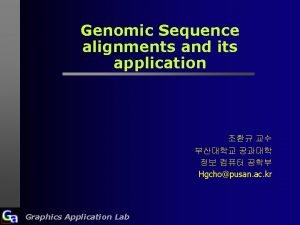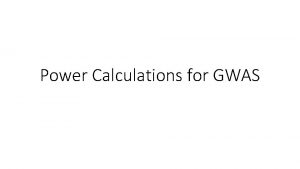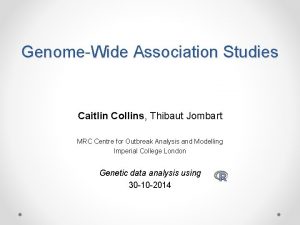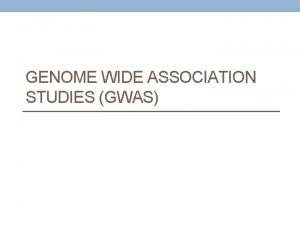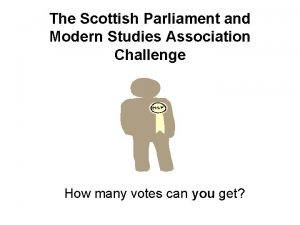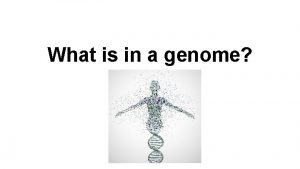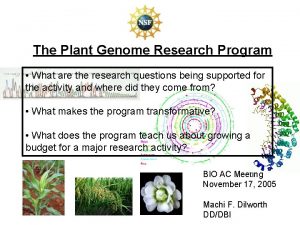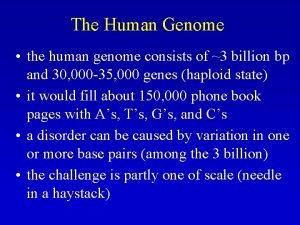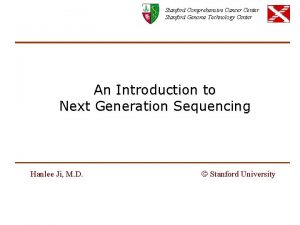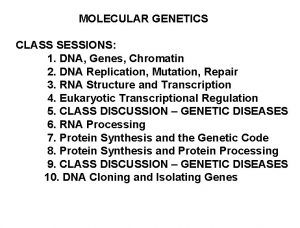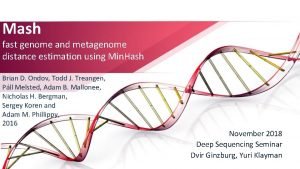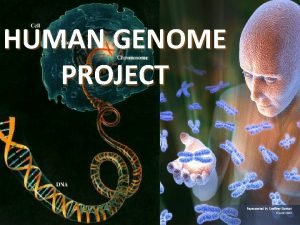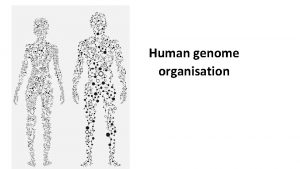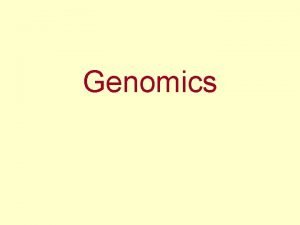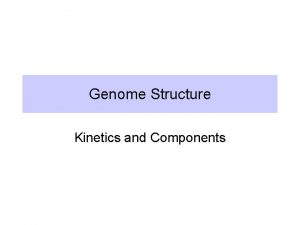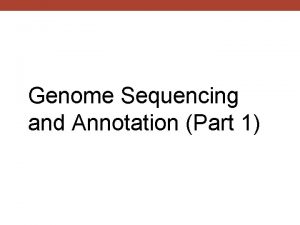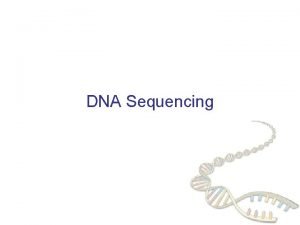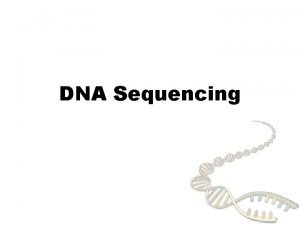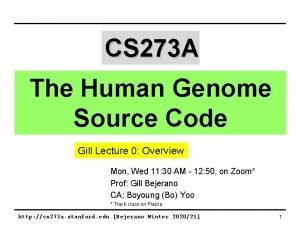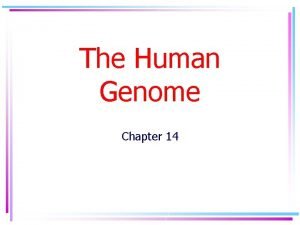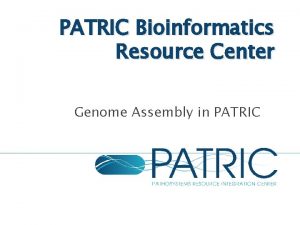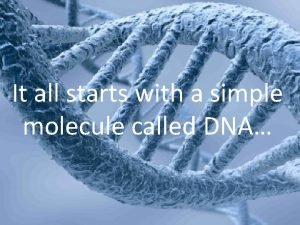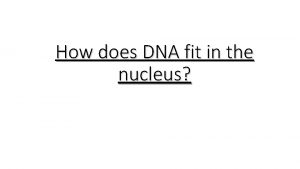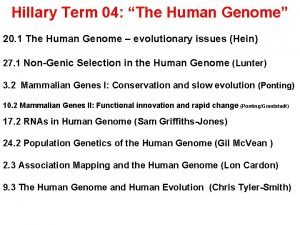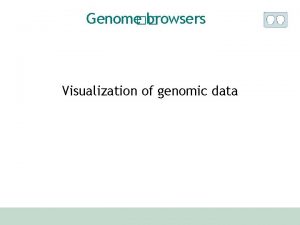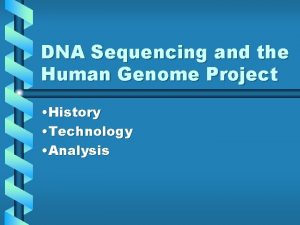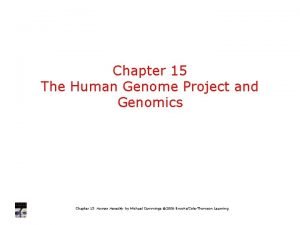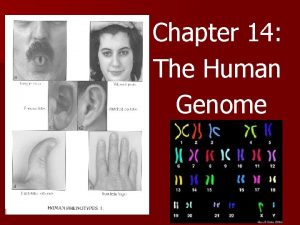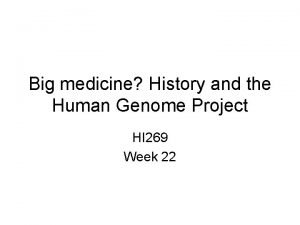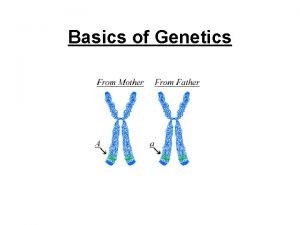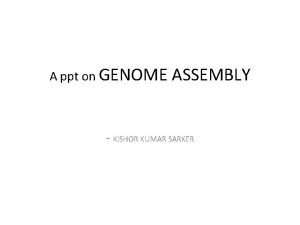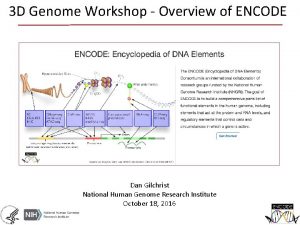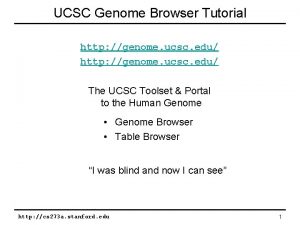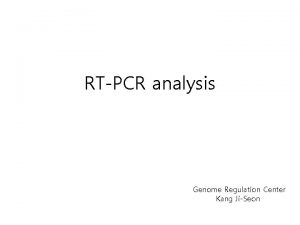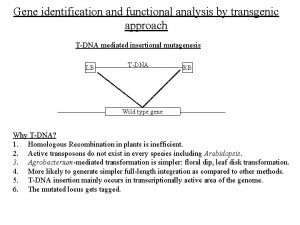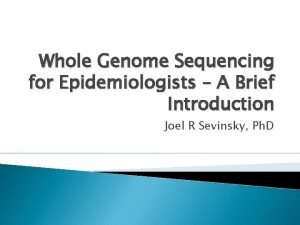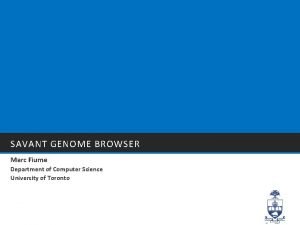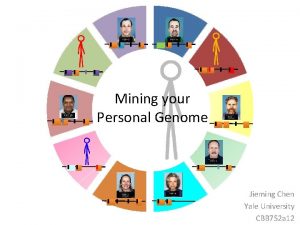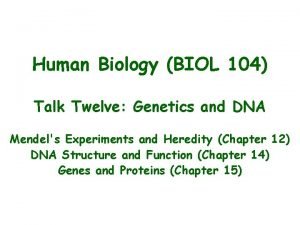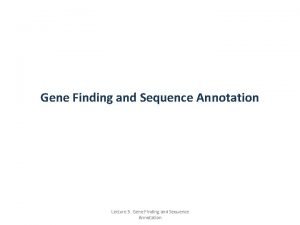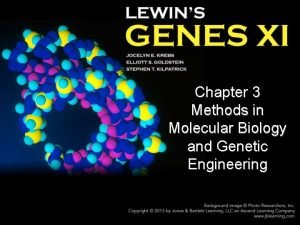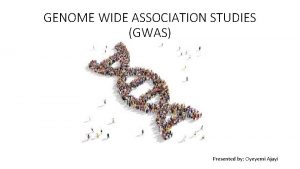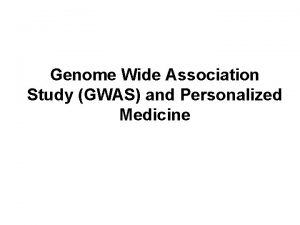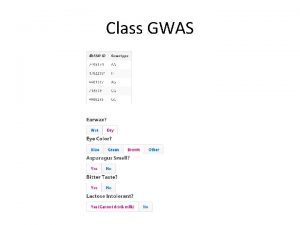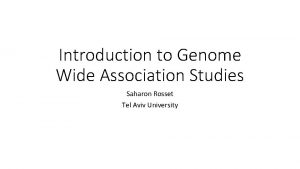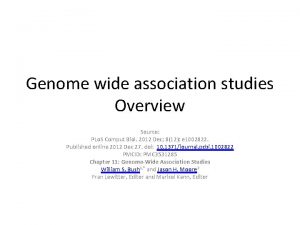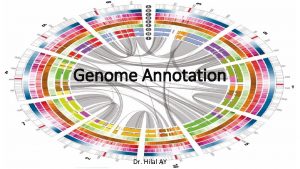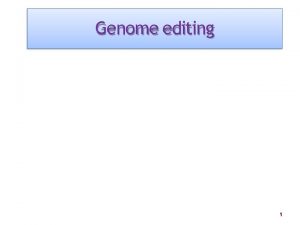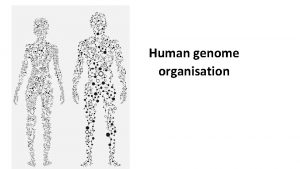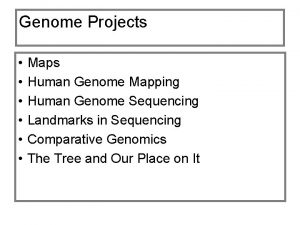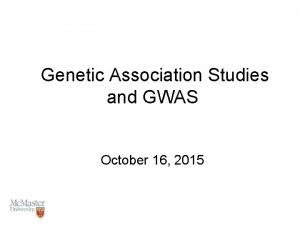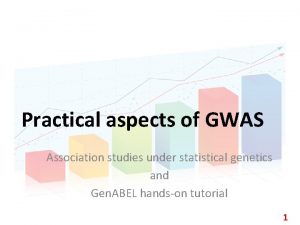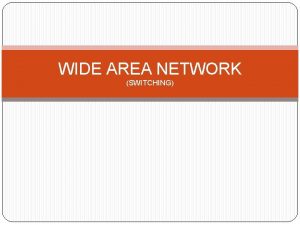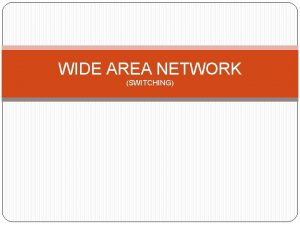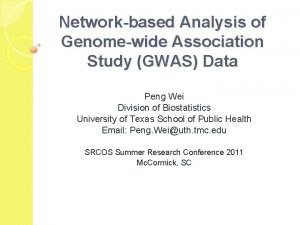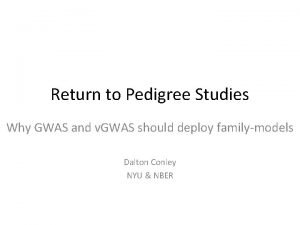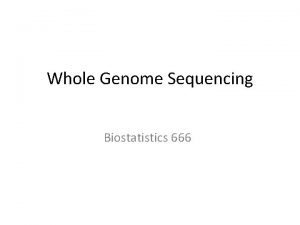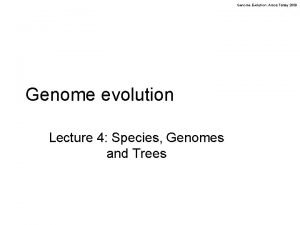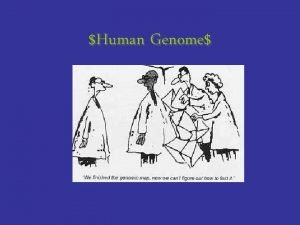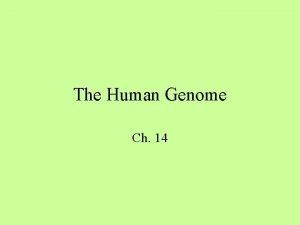GENOME WIDE ASSOCIATION STUDIES GWAS Outline What is















































- Slides: 47

GENOME WIDE ASSOCIATION STUDIES (GWAS)

Outline • What is a Genome Wide Association Study (GWAS) • Points to consider in Conducting and Interpreting GWAS • Post-GWAS Research • Impact of GWAS findings

Genetic Variation and Disease Susceptibility Manolio et al. Nature 2009; 461: 747 -753.

WHAT IS A GENOME WIDE ASSOCIATION STUDY (GWAS)

GWAS DEFINITION • A genome-wide association study is an approach that involves rapidly scanning markers across the complete sets of DNA, or genomes, of many people to find genetic variations associated with a particular disease. • Once new genetic associations are identified, researchers can use the information to develop better strategies to detect, treat and prevent the disease. • Such studies are particularly useful in finding genetic variations that contribute to common, complex diseases, such as asthma, cancer, diabetes, heart disease and mental illnesses. http: //www. genome. gov/20019523

Tools/Discoveries that Made GWAS Possible • First draft of human genome completed June 2000 • Identification and characterization of common genetic variation • Advances in genotyping technology, with reduction in costs

Some Key Concepts for GWAS • Focus on common genetic variants (typically minor allele frequency >5%) • Single Nucleotide Variants (SNPs) are directly genotyped across the genome • SNPs that are genotyped will capture unmeasured variants through linkage disequilibrium. Kruglyak Nature Reviews Genetics 2008; 9: 314 -318.

POINTS TO CONSIDER IN CONDUCTING AND INTERPRETING GWAS

Study Designs Used in GWAS Pearson & Manolio JAMA 2008; 299: 1335 -44

Cohort Case-Control Defined group of study participants People with Variant People without Variant No Have Variant No Variant Have Variant No Variant Downloaded from: Student. Consult (on 29 September 2013 04: 59 PM) © 2005 Elsevier

Sample Size • Variants identified by GWAS have modest effect sizes • Very large sample sizes are needed to detect variants • Sample size often achieved through meta -analysis in consortia Visscher et al. AJHG 2012; 90: 7– 24.

Genomic Coverage of GWAS Chips • estimated by the percent of common SNPs having an r 2 of 0. 8 or greater with at least 1 SNP on the platform. • Platforms comprising 500, 000 to 1, 000 SNPs capture ~67 -89% of common SNPs in populations of European and Asian ancestry and 46 -66% in populations of African ancestry. Nelson et al. G 3 (Bethesda) 2013; 3: 1795– 1807.

Genotyping and Quality Control in GWAS • Genotype “calling” is based on intensities for the two alleles at each genetic marker • Genotyping errors, must be diligently sought and corrected. • Established quality control features should be applied both on a per-sample and a per-SNP basis. Mc. Carthy et al. Nat Rev Genet 2008; 9: 356 -369

Schematic of Typical GWAS imputation >2. 5 million SNPs Schunkert H et al. Eur Heart J 2010; 31: 918– 925.

Common Model: Logistic Regression Population based Association studies • dose=output estimate of # of alternate alleles from imputation • pc=principle components from principle component analysis (PCA)

Principal components analysis • A dimensionality reduction technique used to infer continuous axes of variation. • For GWAS based on SNP x Individual matrix • The first principal component (pc 1) is the linear combination of x-variables that has maximum variance • pc 2 is the linear combination of x-variables that accounts for as much of the remaining variation as possible, with constraint that correlation between pc 1 and pc 2 is 0 • Continue, with constraint that all pcs are orthogonal • Standard calculation in programs such as Eigenstrat, Plink, R, etc.

Captures inter- and intra-continental variability PCA analysis of 1000 Genomes (1000 G, Nature 2012) PCA analysis of European Populations (Nature 2012)

Population Stratification • Population substructure in GWAS data, because allele frequencies differ in different populations • Population stratification= confounding by population substructure • Example: Lactase gene associated with height in European populations • Methods can be used to control for population stratification • Most common method: adjust for top pcs from principle components analysis

19 Q-Q plots (modified by Josh Bis from Mc. Carthy et al. , Nature Reviews Genetics, May 2008)

Manhattan Plot Population based Association studies Compare genotypes in cases and controls Odds ratio for an allele: 1. 35, p = 6. 3 x 10 -10 -log 10(p)=9. 2 Nature 466, 113– 117 (01 July 2010)

21 Regional Plots

NCI-NHGRI Working Group on Replication in Association Studies. Nature 2007; 447: 655 -660. Hirschhorn & Daly, Nat Rev Genet 2005; 6: 95 -108. Evangelou & Ioannidis, Nat Rev Genet 2013; 14: 379– 389.

Meta-Analysis • Large sample sizes required because of small effect sizes, pvalue threshold, misclassification inherent in using tag. SNPs, etc. • Meta-analysis are often used to combine information across studies. • Meta-analysis combines information across studies, creating a weighted average of study specific estimates.

Plink http: //pngu. mgh. harvard. edu/~purcell/plink/ • PLINK is a free, open-source whole genome association analysis toolset, designed to perform a range of basic, large-scale analyses in a computationally efficient manner.

Limitations of GWAS • Countries of recruitment dominated by Europe and North America. • • Possible biases due to case and control selection and genotyping errors • • Addressed through replication, meta-analysis and the use of strict genome-wide significance thresholds. Lack of information on gene function • • Addressed through standards for study design, QC and analysis The potential for false-positive results • • Starting to be addressed through studies of other ancestries. Addressed through post-GWAS functional follow-up studies Insensitivity to rare variants and structural variants • Addressed through alternative study designs

“Missing” Heritability • Additional studies needed • Impact of other types of genetic variation • Less common/rare variants • Copy number and structural variants • Epigenomic variability • Interactions (effect modification) • Gene-environment • Gene-gene (pairwise and networks) • Limitations of study design and disease definitions • Current heritability estimates may be overestimated Maher Nature 2008; 456: 18 -21. Manolio et al. Nature 2009; 461: 747 -753.

Assess the Heritability of a Trait Twin Studies • Compare trait in monozygotic and dizygotic twins • Greater concordance in monozygotic twins reflects genetic similarity Wong A H et al. Hum. Mol. Genet. 2005; 14: R 11 -R 18 Cancer Site Heritable Factors Environmental Factors Shared Non-shared Prostate 0. 42 (0. 29 -0. 50) 0 (0 -0. 09) 0. 58 (0. 50 -0. 67) Colorectal 0. 35 (0. 10 -0. 48) 0. 05 (0 -0. 23) 0. 60 (0. 52 -0. 70) Bladder 0. 31 (0. 00 -0. 45) 0 (0 -0. 28) 0. 69 (0. 53 -0. 86) Breast 0. 27 (0. 04 -0. 41) 0. 06 (0 -0. 22) 0. 67 (0. 56 -0. 76) Lung 0. 26 (0. 00 -0. 49) 0. 12 (0 -0. 34) 0. 62 (0. 51 -0. 73) Source: Scandinavian Twin Registry, Lichtenstein et al. New Engl J Med 2000

Contribution of Genetic Variants to Disease Heritability http: //www. nature. com/nrg/journal/v 15/n 11/full/nrg 3786. html

GWAS FINDINGS

Catalog of Published GWAS http: //www. genome. gov/gwastudies/ now http: //www. ebi. ac. uk/gwas/

Front. Genet. , 20 April 2015 | http: //dx. doi. org/10. 3389/fgene. 2015. 00149

GWAS SNP-Trait Discovery Timeline Data used for generating the graph were taken from the GWAS Catalogue. 10 SNPs and traits were selected according to the following filters. SNPs were selected with a p value < 5 × 10− 8. For each trait with two or more selected SNPs, SNPs were removed if they had an LD r 2 > 0. 5 (calculated from 1000 Genomes phase 3 data) with another selected SNPs and their p value was larger. For each year of discovery, only the top three traits and diseases with the largest number of SNPs are labeled in the circle. 10 Years of GWAS Discovery: Biology, Function, and Translation Peter M. Visscher, Naomi R. Wray, Qian Zhang, Pamela Sklar, Mark I. Mc. Carthy, Matthew A. Brown, Jian Yang Volume 101, Issue 1, 2017, 5– 22 http: //dx. doi. org/10. 1016/j. ajhg. 2017. 06. 005

POST-GWAS RESEARCH

The Post-GWAS Continum • Follow-up studies and analysis to capitalize on and expand GWAS findings • Each step builds on the knowledge gained from the preceding studies http: //epi. grants. cancer. gov/pgwas/index. html

10 Years of GWAS Discovery: Biology, Function, and Translation Peter M. Visscher, Naomi R. Wray, Qian Zhang, Pamela Sklar, Mark I. Mc. Carthy, Matthew A. Brown, Jian Yang Volume 101, Issue 1, 2017, 5– 22 http: //dx. doi. org/10. 1016/j. ajhg. 2017. 06. 005

Nature i. COGS • Large scale results for breast, ovarian and prostate cancer • Collaborative Oncological Gene- environment Study (COGS) • Published Online March 27, 2013 • Simultaneous publication of 13 papers, commentaries, editorials and hypertexted essays. Includes: • Commentary: Public health implications from COGS and potential for risk stratification and screening • Primer: Risk prediction and population screening for breast, ovarian and prostate cancers www. nature. com/icogs/

Key COGS Findings Breast Cancer • GWAS meta-analyis of 10, 052 cases and 12, 575 controls • Replication in 45, 290 cases and 41, 880 controls • Identified 41 new loci • Top 5% and 1% of risk distribution have 2. 3 fold and 3 fold higher risk than average population. Prostate Cancer • GWAS meta-analysis of 11, 085 cases and 11, 463 controls • Replication in 25, 074 cases and 24, 272 controls • Identified 23 new loci • Top 1% of risk distribution has 4. 7 higher risk than average population. Michailidou et al. Nature Genetics 2013: 45, 353– 361. Eeles et al. Nature Genetics 2013: 45, 385 -391.

Pleiotropy in COGS and other Cancer GWAS • Pleiotropy= a single locus influencing two or more traits. • Several findings from GWAS are shared among different cancer types. Sakoda et al. Nature Genetics 2013: 45, 345– 348.

Pleiotropy in GWAS • Numerous examples of GWAS findings impacting more than one trait. • Pleiotropy scans can identify novel loci. Am J Hum Genet. Nov 11, 2011; 89(5): 607– 618.

Fine-Mapping • Genotype additional SNPs to narrow down the region of interest • Targeted resequencing, to gain additional information on sequence variation in the area of interest Ioannidis et al. Nat Rev Genet 2009; 10: 318 -329. Altshuler Science. 2008; 322: 881 -8.

Post-GWAS Biological Studies • Identification of risk- modifying variants • Determination of biological mechanism of risk-enhancement • Examination of functional consequences of variant Monteiro & Freedman. J Int Med 2013; 274: 414 -424.

42 Genome-Wide Functional Annotation Mostly cell lines ANNOTATION DATABASE Tissue samples

43 Functional Attributes of Regulatory Regions DNase I Hypersensitivity Epigenetic Transcription Factor/ Protein Binding Ch. IP-Seq Reference Genome Enhancer Promoter Gene

Variants in Regulatory Regions • Use of ENCODE data • SNPs identified in GWAS studies (red bar) often lie in enhancers or other regulatory elements. • Smaller fraction of control SNP sets overlap with these features (blue bars) • SNPs on Illumina 2. 5 M chip • SNPs in 1000 Genomes • SNPs from 24 personal Genomes Manolio Nat Rev Genet. 2013; 14: 549 -58.

Genetic Risk Scores • The 31 -SNP risk allele distribution in patients with venous thrombosis and control subjects and corresponding ORs. Blood 2012 120: 656 -663; doi: https: //doi. org/10. 1182/blood-2011 -12 -397752 Figure 1. Summary of risk of coronary heart disease across genetic risk score categories in primary and secondary prevention populations The Lancet Volume 385, Issue 9984, 6– 12 June 2015, Pages 2264 -2271

Examples of Links between GWAS Discoveries and Drugs 10 Years of GWAS Discovery: Biology, Function, and Translation Peter M. Visscher, Naomi R. Wray, Qian Zhang, Pamela Sklar, Mark I. Mc. Carthy, Matthew A. Brown, Jian Yang Volume 101, Issue 1, 2017, 5– 22 http: //dx. doi. org/10. 1016/j. ajhg. 2017. 06. 005

Take Home Points • Complex diseases are influenced by a combination of genetic and environmental factors. • Genome-wide association studies (GWAS) can be used to identify common genetic variants associated with complex diseases. • GWAS have evolved standards for study design, analysis, replication and interpretation. • GWAS, to date, have identified over 2, 000 variants associated with over 300 traits, including hundreds of variants associated with common cancers. • Post-GWAS research includes discovery and replication, biological and functional follow-up and epidemiologic studies. • GWAS have reveled new biology of complex diseases, and some GWAS findings are readily translatable to clinical care.
 Semi-global alignment
Semi-global alignment Gwas power calculation
Gwas power calculation Gwas method
Gwas method Gwas
Gwas What is a mid shot
What is a mid shot Paradigm shift from women studies to gender studies
Paradigm shift from women studies to gender studies Social studies essay
Social studies essay Modern studies association
Modern studies association Sentence outline examples
Sentence outline examples Genome is
Genome is Plant genome research program
Plant genome research program Euphenics
Euphenics Stanford
Stanford Human genome size
Human genome size Min-hash
Min-hash Human genome size
Human genome size Future of human genome project
Future of human genome project Human genome structure
Human genome structure Per partes
Per partes Human genome structure
Human genome structure Hierarchical shotgun sequencing vs whole genome
Hierarchical shotgun sequencing vs whole genome Shotgun sequencing
Shotgun sequencing Genome sequencing
Genome sequencing Human genome project source code
Human genome project source code Sickle cell karyotype
Sickle cell karyotype Patric genome
Patric genome National human genome research institute
National human genome research institute Genome modification ustaz auni
Genome modification ustaz auni National human genome research institute
National human genome research institute Human genome project
Human genome project Genome klick
Genome klick History of sequencing
History of sequencing Chapter 15 the human genome answer key
Chapter 15 the human genome answer key Chapter 14 the human genome
Chapter 14 the human genome Human genome project
Human genome project Turner syndrome
Turner syndrome Genome assembly and annotation ppt
Genome assembly and annotation ppt National human genome research institute
National human genome research institute Ucsc genome browser tutorial
Ucsc genome browser tutorial Genome
Genome Functional dna
Functional dna Genome sequencing
Genome sequencing Marc fiume
Marc fiume Genome.gov
Genome.gov Ribosomes structures
Ribosomes structures 1000 genome project
1000 genome project Prokaryotic gene structure
Prokaryotic gene structure Genome.gov
Genome.gov
